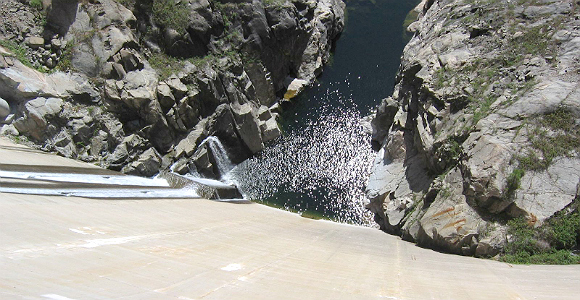
Hetch Hetchy dam. (Photo Credit: Jessica Merz/Flickr)
Only a few months after voters overwhelmingly approved the $7.5 billion water bond known as Proposition 1, the California Economic Summit is urging state lawmakers to give water agencies more precise direction for allocating these funds—and to provide systematic oversight so voters can see how this money is being spent.
Summit leaders offered these recommendations in testimony submitted today to the Assembly Committee on Water, Parks, and Wildlife, which last year earned plaudits for drafting clearly-defined “principles” for the bond—from prohibiting earmarks to increasing accountability—that many credit with contributing to the measure’s success.
With California’s drought lingering, the Summit remains focused on ensuring bond funds allow regions to take “the right next steps” toward sustainability. Echoing a set of Summit drought-response proposals released last year, the testimony emphasizes the need not just for more investment to the state’s aging water infrastructure, but for smarter investment that encourages more comprehensive governance of the fragmented water system—and more comprehensive solutions to the state’s water challenges.
Three ideas for implementing Prop 1
Today’s Summit testimony highlights three ways state leaders charged with implementing Prop 1 can accomplish these goals—all drawn from the Summit’s Roadmap to Shared Prosperity, a long-term plan for putting all of the state’s regions on a path to sustainable growth.
1. Refine the state role. The Summit has encouraged state leaders to use the water bond to advance state goals for water resiliency—with state government providing financial incentives and gap financing for projects that meet the priorities outlined in the California Water Action Plan. The Summit notes an immediate opportunity in the bond’s $100 million allocation for enhancements to “an urban creek”—a funding stream that could support a range of urban restoration projects, including the Los Angeles River. The Summit has already begun working with the City of Los Angeles on how the new authority of Enhanced Infrastructure Financing Districts could leverage bond funds to support river restoration.
2. Support integrated, multi-benefit projects across watersheds. Summit leaders have also urged the state to ensure Prop 1 advances the new paradigm where the state sets goals and regions compete to craft strategies that deliver the most benefit. This approach can be found in two different sections of the measure, which together add up to $2.3 billion:
Watersheds: The $1.495 billion watershed chapter is made up entirely of “competitive grants for multi-benefit ecosystem and watershed protection and restoration projects in accordance with statewide priorities.” The legislation provides a detailed list of ways these dollars can be used, giving highest priority to “multi-benefit” projects that could reduce fire danger, for example, while also increasing water supply, improving water quality, reducing flood impacts, and replenishing aquifers. The Summit notes that Prop 1 only allocates $38 million to the Sierra-Cascade region—meaning 0.5 percent of the bond’s total funds will go directly to the upper mountain watersheds that provide two-thirds of the state’s runoff. Still, the Summit letters outlines a variety of ways mountain regions can compete for more funds, connect these projects with their beneficiaries in the more populous valleys below, and ensure beneficial uses of water throughout the watershed—all keys to water sustainability.
Integrated water management: Prop 1 also allocates $810 million to “regional water management”—a decade-long effort to connect projects in upper and lower watersheds—with the measure directing funds first to projects “that cover a greater portion of the watershed.” The Summit letter calls out several opportunities for increasing these efforts—urging lawmakers to use bond funds to encourage local water agencies to accelerate development of their newly-required groundwater management plans, for example. The Summit also calls attention to its ongoing work with cities and local water agencies to identify ways to bring multiple local governments together to develop projects that capture and store stormwater.
3. Maximize return on investment: Before Prop 1 passed, many stakeholders expressed concern over how the state will spend $2.7 billion allocated to storage projects—a looming choice between funding new dams or investing in alternative means of storage. While the bond’s storage funds won’t be allocated for years, the Summit letter notes that Prop 1 outlines a set of laudable goals for distributing these dollars—with the measure requiring the California Water Commission to create a competitive process “that ranks potential projects based on the expected return for public investment as measured by the magnitude of the public benefits provided.” The Summit letter notes several ideas for how the state can ensure these new funds help water agencies more effectively coordinate surface and groundwater storage, conveyance, and habitat restoration.
Since the debate over Prop 1 began, the Summit has made the case that implementing the bond would be as important as the passage of the measure itself. The Summit letter makes the case that the bond’s language sets the bar high—and gives the Summit’s civic leaders an opportunity to work with lawmakers to ensure these funds help California begin the long journey to water sustainability.

